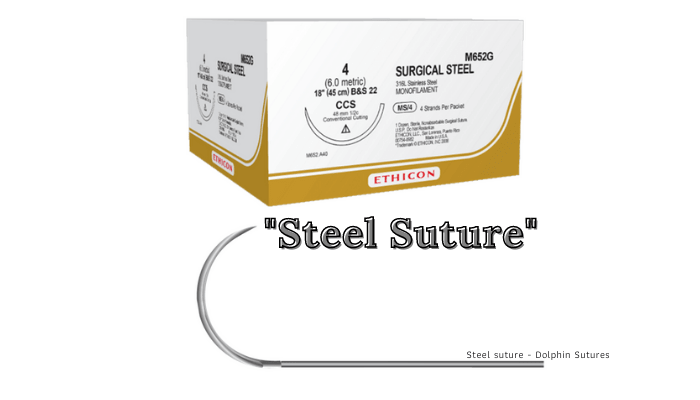Composition
Stainless steel suture are rust proof, synthetic, non-absorbable metallic sutures composed of 316L stainless steel / chromium, nickel, and molybdenum alloyed vacuum re-melted stainless steel. It is available as simple or twisted / monofilament or multi-filament suture.
Colour
Stainless steel sutures are available in uncoated and undyed forms with natural stainless colour. It has smooth finish and less tissue drag and trauma.
Absorption
Stainless steel suture is non-absorbable in nature. It is neither absorbed by the tissue nor disintegrated by enzymes. It is gradually encapsulated in the fibrous connective tissue.
It is easy to remove or pull out because it lacks adherence to the body tissue.
Tissue Reaction
Ethylene oxide is used for sterilization. It can be easily sterilized by autoclaving and incites no inflammatory reaction as it is a completely bio-inert material (sometimes grade 1 tissue reaction with slight reactivity in sensitive patients).
Tensile strength
It has the highest in vivo tensile strength and greatest knot security among all the suture materials available. Need extra throws when knotting monofilament stainless steel sutures. It retains tensile strength for indefinite period in vivo.
Indications
Stainless steel wire has gained wide acceptance and is used as internal and external sutures. Most common use of the stainless steel surgical suture is in the orthopedic surgical procedures.
It is used to hold or repair slow healing tissues like ligaments and tendons. Stainless steel sutures are also indicated in case of abdominal wound closure, intestinal anastmosis, hernial repairs, orthopedic procedures (cerclage wire) and sternal closure. Simple stainless steel sutures can be used in contaminated and infected wounds.
Stainless steel sutures have also been used in ophthalmic surgeries for trans-scleral fixation for the posterior chamber intraocular lenses (IOL).
Limitations
The main disadvantage of stainless steel is its poor handling quality.
Moreover, it has tendency to cut through the tissues and due to malleable nature may break down following repeated bending or during knotting. In orthopedic procedures suture merges with bone contours. Wound dehiscence may vary with site infection and site of application. Sometimes it may cause tissue necrosis.
Contraindications
It is contraindicated in patients where radio-transparency is required or in case of having known sensitivity / allergies to steel or its metallic components like chromium or nickel.
Stainless steel sutures may interfere with radiodiagnostic procedures.
Suture sizes
It is available in various gauze sizes ranging from 1-8 and 0 to 6/0 and lengths without needles or with a variety of swaged needles like blunt taper cutting, reverse cutting and conventional cutting needles.
Storage
Standard suture handling guidelines should be followed. Reuse and resterilization may increase the risk of contamination and infection.
Storage is recommended between 10oC – 35°C in dry conditions.
Shelf life of surgical steel sutures is up to 5 years.
Fig: Stainless steel sutures by Dolphin sutures
Fig: Stainless steel sutures by Ethicon
FAQs
Stainless steel suture which has minimum contain iron in alloy are compatible with MRI or Nuclear magnetic resonance imaging (3.0 T or Less). Image distortion can be seen. MRI technician must be informed if any metallic implant is there.
Stainless steel sutures are indicated for the use in orthopedic surgical procedures, ligaments and tendon repair. Stainless steel sutures are also indicated in case of abdominal wound closure, intestinal anastmosis, hernial repairs, orthopedic procedures (cerclage wire) and sternal closures.
Synthetic. Stainless steel is a synthetic non-absorbable suture material.
Not all the sutures are metallic in nature. A few non-absorbable suture like stainless steel, tantalum, gold, silver etc are metallic.
No, Surgical steel is variety of stainless steel which is the most corrosion resistant form. Higher chromium content of the alloy prevents oxidation /corrosion. Example: austenitic 316, martensitic 440 and 420 stainless
Surgical cutting instruments are made from the stainless steel 440 or 420 but they are less corrosion resistant than 316 L.
No, Surgical stainless steel suture are synthetic non-absorbable metallic sutures.
Surgical steel may be slightly magnetic.
It is the surgical steel austenitic 316 L. VM stands for vac melt (vacuum melted) which means 316 stainless steel which has been vacuum melted.
